PONCE DE LEON LIGHTHOUSE
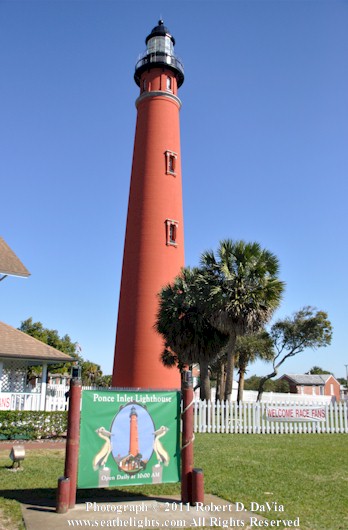
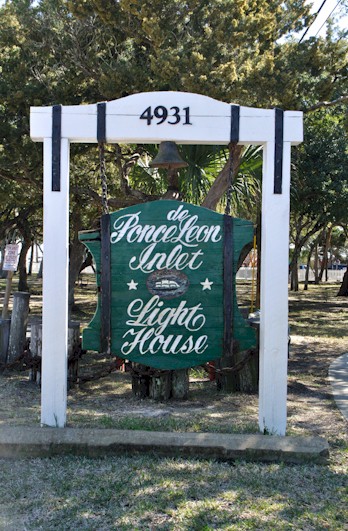
The following information is from a brochure handed out at the lighthouse.
The days of the blue uniformed lighthouse keepers, checking their oil supply and slowly climbing the tower to clean the lens, have passed forever, yet their lighthouse remains. Step back in time and experience what it was like living at this remote location in the late 1800s. You are visiting one of the few Light Stations in the United States with all of the original keepers' dwellings and support buildings intact. Completed in 1887, the Ponce de Leon Inlet Light Station is a National Historic Landmark and has, for over 120 years, guided mariners safely to their destinations.
During the 1800s, shipwrecks along the east coast of Florida were increasing at an alarming rate. The United States Light-house Board visited the area and determined a lighthouse was needed between Saint Augustine and Cape Canaveral. The Board recommended Mosquito (now Ponce) Inlet, with its increasing marine traffic and known for its strong currents and shifting sandbars, as the prime location for the new lighthouse. Built of over one million bricks shipped from Maryland and New York, the Ponce de Leon Inlet Lighthouse stands today as an active aid to navigation in an area still dreaded by mariners.
Begun in 1884, the 175-foot tall lighthouse tower was a modification of the Light-House Board's standard plan for tall masonry towers. Activated for the first time on November 1, 1887, the lighthouse was illuminated by a kerosene lantern located within a first order fixed Fresnel Lens made by Barbier et Fenestre of Paris, France. In 1933, the Lighthouse Service electrified the tower and changed the beacon to a flashing characteristic. A rotating third order Fresnel Lens was installed.
In 1970, the Coast Guard established a beacon on the south side of the inlet and abandoned the lighthouse. Concerned members of the community formed the Ponce de Leon Inlet Lighthouse Preservation Association and persuaded the Town of Ponce Inlet to acquire the deed to the Light Station from the Coast Guard in 1972. The Preservation Association undertook its mission to restore the facility to create a museum. In late 1982, the Coast Guard installed a modern beacon in the tower, and the Lighthouse was officially reactivated and returned to its original use as an aid to navigation.
In 2004, museum staff completed the restoration of the 1933 Rotating Third Order Fresnel Lens, and the lens was re-installed in the tower. With the Coast Guard's permission, the 1933 characteristic was reinstated, and the Lighthouse became a private aid to navigation, maintained by museum staff.
Today, the Light Station grounds and museum include an entrance building based on the original plans for a multi-family keepers' dwelling which was never built, the lighthouse tower, three original keepers' homes and their out-buildings, a boatyard area, lens exhibit building, oil storage building, pump house, a nature walk, and a restroom facility.
Entrance Building and Gift Shop
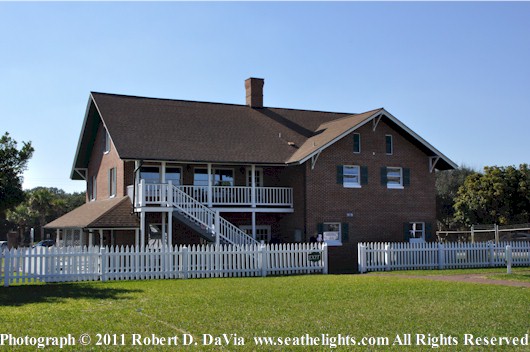
Click picture to enlarge
Built in 1992 from plans drawn in 1883 for a proposed multi-family keeper's dwelling, this building contains restrooms, water fountains, and the Light Station Gift Shop which features a wide assortment of unique maritime and lighthouse themed merchandise for young and old alike. Many of these items may also be purchased online at www.poncelighthousestore.org.
Woodshed Video Theater and Privy Exhibit
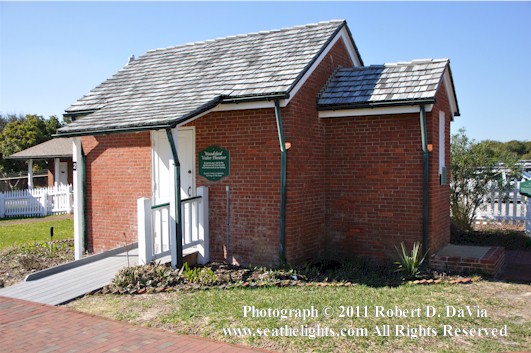
Click picture to enlarge
Firewood and other supplies were kept in this building by the Second Assistant Keeper's family. It is now home to the video theater where you can watch a twenty minute program about the history of the Light Station. On the northeast side of this building you will find the privy, restored as it was when it served as this family's restroom.
Second Assistant Keeper's Dwelling
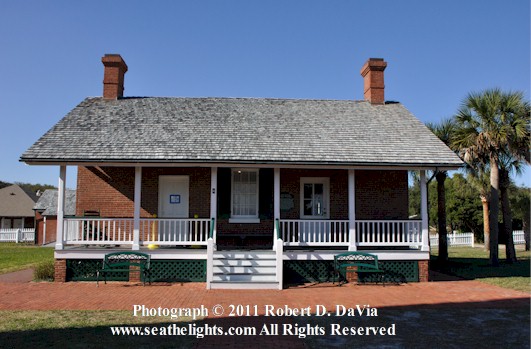
Click picture to enlarge
One of the three original buildings that served as homes for the light keepers and their families, this building also functioned in the early 1960's as the first town hall for the Town of Ponce Inlet. The dwelling is now home to multiple exhibits related to the development of the local community, historic beach racing, and the lives of the keepers and their families. Items on display include vintage clothing and uniforms, time pieces, and numerous artifacts unearthed within the historic grounds.
Principal Keeper's Dwelling
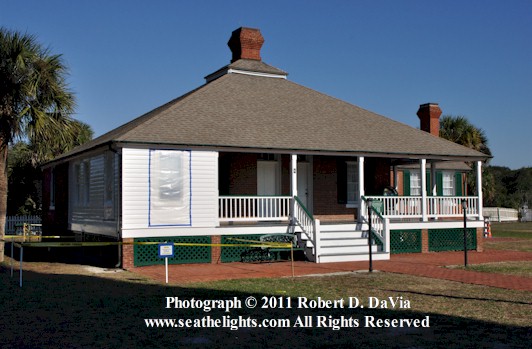
Click picture to enlarge
The largest of the original Light Station dwellings, this building was the home of the Principal Keeper and his family. It now houses a variety of exhibits including The Keeper's Office, Native Americans in Florida, Filibustering to Cuba, the 1921 Bathroom Addition, Construction and Restoration of the Light Station, and Lighthouses of the World.
The Lighthouse Tower
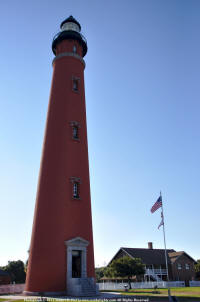
Click picture to enlarge
Soaring 175 feet into the sky, the Ponce de Leon Inlet Lighthouse is the tallest lighthouse in Florida and one of the tallest in the nation. Standing atop a 12-foot deep by 45-foot wide foundation of brick, the picturesque tower tapers inwards from its 32-foot diameter base to 12 foot diameter top. The brick walls are eight feet thick at the bottom and two feet thick at the top. It took one and a quarter million bricks and three years to build. Including the nine granite steps at the entrance, there are 203 steps to the gallery deck.
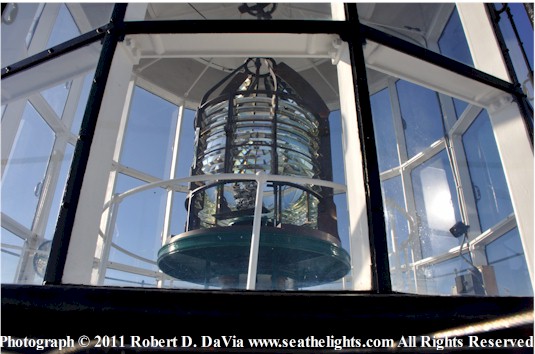
Third-Order Fresnel Lens atop the tower, picture shot from outside.
The first beacon was a First Order Fixed Fresnel Lens, manufactured in Paris by Barbier et Fenestre and illuminated by a five concentric wick kerosene lantern whose light could be seen nearly 20 miles out to sea. In 1933, the Lighthouse was electrified and the First Order lens was replaced with a Barbier, Benare, et Turenne Rotating Third Order Fresnel Lens. Illuminated by a 500-watt frosted bulb, the beacon could be seen 18 miles at sea. The characteristic or pattern of flashes for this lens was 6 half-second flashes in 15 seconds, followed by a 15-second eclipse or period of darkness.
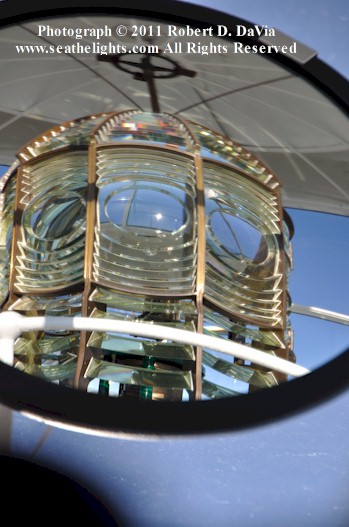
The current Fresnel Lens, as viewed reflected in a mirror atop the lighthouse.
The Third Order lens has been restored by the museum staff and continues in operation today as a private aid to navigation using its historic characteristic. It is now illuminated by a 1000-watt lamp.
Pump House
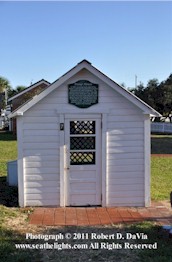
Click picture to enlarge
In 1906, an artesian well was dug just ten yards south of the lighthouse tower. The following year a windmill and water tower were erected over the well to provide water to the keepers' dwellings. In 1915, the present building was constructed to house a gasoline-powered pump that replaced the windmill. Today, an electric pump still provides water from this well to irrigate the grounds.
First Assistant Keeper's Dwelling
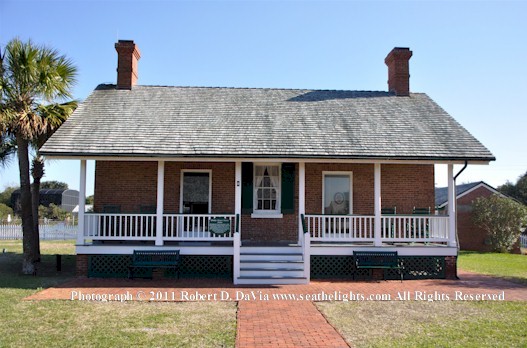
Click picture to enlarge
This dwelling is named in honor of Gladys Meyer Davis, a lifelong resident of Ponce Inlet who was born in this building. Her father, Edward L. Meyer, was the last Lighthouse Service Principal Keeper at the the Ponce de Leon Inlet Light Station. The building is furnished as it would have been at the turn of the century. In the kitchen, seen from the rear of the house, are two "kitchen dressers" that were part of the original 1887 design. The table and chairs are from the Meyer family. The interior of the First Assistant Keeper's Dwelling is visible through viewing panels on the front and back porches. Visitor access to these spaces is prohibited to protect the building's historic furnishings.
Generator Building
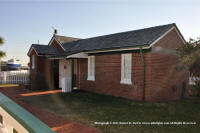
The south part of this building was used for storage and as a privy by the First Assistant Keeper's family. In 1940, two electric generators, including the one still here, were installed to provide electricity to the Light Station and power for the radio beacon equipment. The north side of this building was constructed by the Coast Guard to house additional radio beacon equipment used to guide coastal shipping during World War II. Exhibits on World War II at the lighthouse, a recreation of the radio beacon station, and weather monitoring equipment are on view.
Lens Exhibit Building
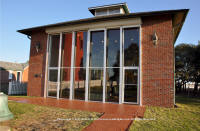
Click picture to enlarge
Constructed in 1995, this building houses a collection of lighthouses lenses including two fully restored first order Fresnel lenses, a rare English-made third-and-a-half order lens, a fourth order bi-valve or "clamshell" Fresnel lens, a reproduction sixth order lens, small navigational aids, modern lighthouse beacons, lighthouse artifacts, and exhibits explaining the history and technology of lighthouse illumination as well as the process of Fresnel lens restoration. The magnificent rotating first order Fresnel lens from the Cape Canaveral Lighthouse is on display here along with the original fixed first order Fresnel lens that served as the Ponce Inlet Lighthouse's beacon from 1887 until 1933. The historic lenses on view were restored by a team of museum staff and volunteers. This building is named in honor of Ayres Davies, a founding member of the Ponce de Leon Inlet Lighthouse Preservation Association.
U.S. Lighthouse Service Bell
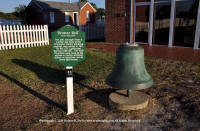
Click picture to enlarge
This 1,000-pound bell was mounted on a sea buoy at the entrance of Charleston Harbor, South Carolina. Bells like these were used as fog signals by the Lighthouse Service. Soon after installation, this bell sank in a storm. It was recovered by the U.S. Coast Guard in 1987 and donated to the Light Station.
Oil Storage Building
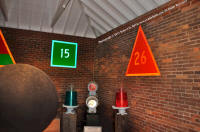
Built with a unique double-wall ventilation system for safety, this structure was one of the first and largest of its kind ever built for the storage of kerosene. Approximately five gallons of kerosene were burned per night to light the lens. Kerosene, or "mineral oil" as it was called then, was stored in 504 five-gallon cans on shelves inside. The shelves were replaced in 1927 by two large iron tanks, which remain in the building today. Partially burned by vandals in 1970, the Oil Storage Building was fully restored in 1989. Today it houses examples of minor aids to navigation.
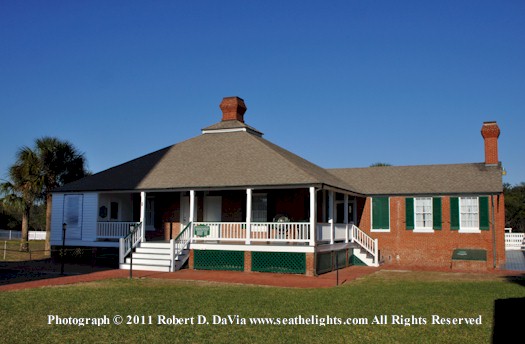
Principal Keeper's Dwelling
This building was the home of the Station's Principal Keeper and his family.
It also contained the Light Station office and library.
The U.S. Lighthouse Service Principal Keepers who served here are:
William R. Rowlinski 1887-1893
Thomas P. O'Hagan 1893-1905
John Lindquist 1905-1924
Charles L. Sisson 1924-1926
John B. Butler 1926-1937
Edward L. Meyer 1937-1943
The Principal Keeper's Office
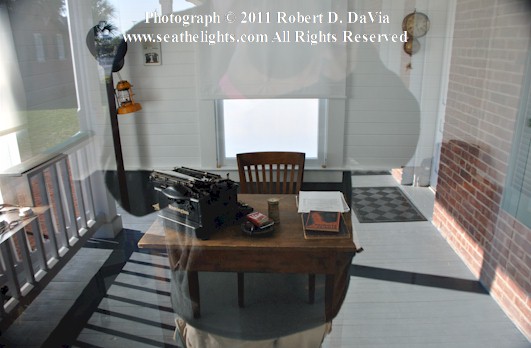
In 1921, the Lighthouse Service enclosed portions of the porch on each dwelling at the Light Station in order to install bathroom facilities for the families. A small office room was included in this upgrade when the porch of the Principal Keeper's dwelling was enclosed. The office was used by the Principal Keepers and, after 1939, by each Coast Guard Officer-In-Charge.
VIEWS FROM THE TOP
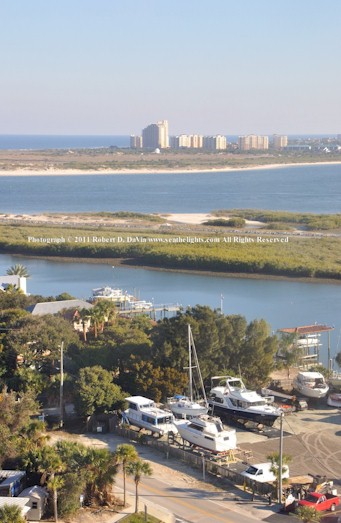
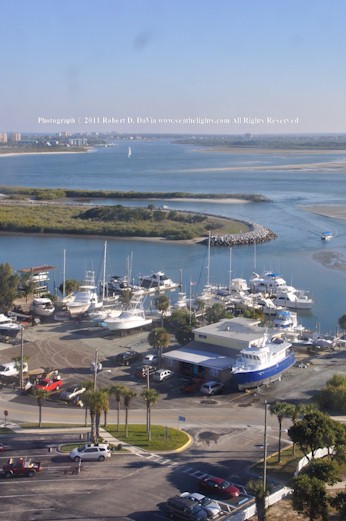
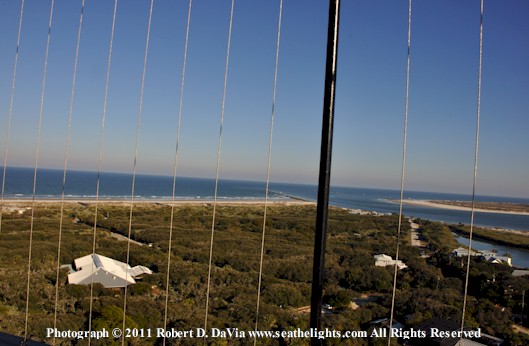
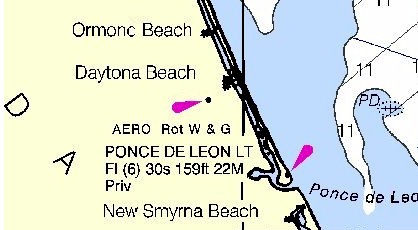
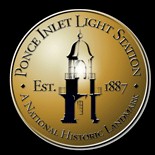
Visit the Ponce de Leon Inlet Light Station Website
